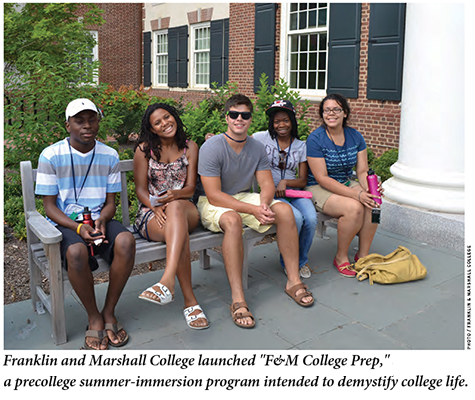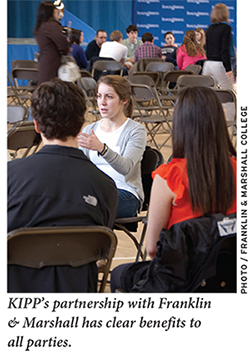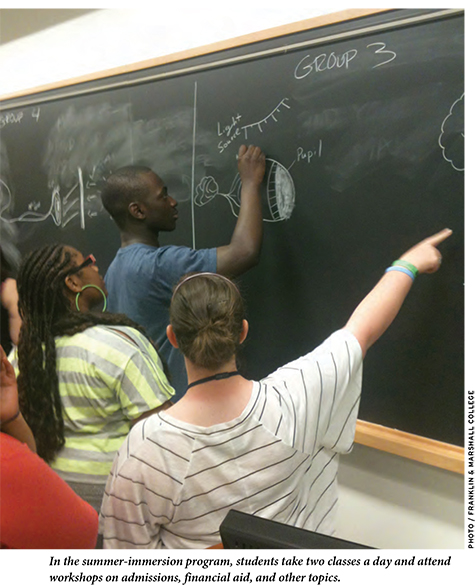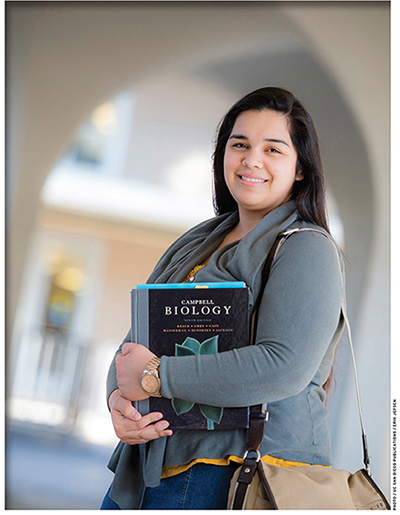The C in linguistics proved to Rebecca Mercado that college was going to be different.
“It was the first time I had ever received a grade lower than a B, and it was upsetting,” admits Mercado, a biochemistry and cell biology major at the University of California, San Diego. The first in her family to attend a four-year college, Mercado was a strong student dating all the way back to her days in middle school at San Diego’s KIPP Adelante Preparatory Academy. Perhaps as a result, she was “a little more cocky than I should have been” when arriving on campus for freshman year. Like many freshmen, Mercado experienced the distraction of being on her own for the first time, which took a toll on her grades. Holding down a job while taking more classes than she could handle didn’t help. “It all came crashing down on top of me,” Mercado says. Freshman year was “a big dose of reality,” she says.
Here’s another one: statistically speaking, Mercado might have been voted “Least Likely to Succeed” at birth. Low-income black and Hispanic students are by far the least likely U.S. students to graduate from high school and attend a four-year college. Those who are accepted to college are least likely to stick around and earn a degree. For each one who earns a bachelor’s degree, 11 fall short somewhere along the line, giving students like Mercado a mere 8 percent chance of graduating from college.
Mercado persists. Reenergized after a summer internship with the KIPP Foundation in Chicago, she is back on campus for the fall semester of 2012. She credits the habits of mind and encouragement she received in middle school, and the contacts she maintains five years later with KIPP teachers and administrators, for propelling her forward. “This year I’m coming in with a clear head. I’m more focused on my classes and what I want to accomplish. I’m going to do better,” she says. Her delivery communicates not hope or aspiration but conviction. “Nothing is going to keep me from graduating,” she insists, adding for emphasis, “nothing.”
Mercado’s story—both her struggle and her determination— will be repeated over the next several years on college campuses across the U.S. At one level, she’s just one more kid trying to pass biology, graduate, and make something of herself. But as the product of a KIPP school, Mercado is at the vanguard of a rapidly growing class of students whose success or failure could make or break the reputation of a closely watched group of charter schools and the sometimes-controversial, muscular brand of education they have pioneered. In 2015, more than 10,000 students from KIPP and other major charter-school highfliers will be on college campuses across the United States.
The Coming KIPP Bubble
You can’t play the ingenue forever.
For much of its brief history, there has been something of a halo over the Knowledge Is Power Program (KIPP). Founded in Houston in 1994 by Mike Feinberg and Dave Levin, a pair of Teach For America corps members, KIPP now has more than 100 schools in 20 states and Washington, D.C. It is the largest and best known of a class of charter-management organizations (CMOs) that includes Achievement First, YES Prep, Uncommon Schools, Mastery, Aspire, and others. This group shares a set of familiar characteristics: more and longer school days, with a college preparatory curriculum for all students; strict behavioral and disciplinary codes; and a strong focus on building a common, high-intensity school culture. Classrooms and halls are awash in motivational quotations and college banners, typically from the alma maters of the inevitably young, hard-charging teachers who staff the schools. The signature feature is high behavioral and academic expectations for all students, the vast majority of whom are low-income, urban black and Hispanic kids. It’s this last feature that led KIPP and the others to be branded “No Excuses” schools, a label not universally embraced within the category.
 The reputation of the No Excuses model is complicated and often divisive among professional educators. Outside the education bubble in the broader public mind, however, these high-flying charters are much-adored, attractive young upstarts, and the antidote to the dark, dispiriting “dropout factories” of media caricature. For years, a central motif of the feel-good narrative surrounding No Excuses charter schools has been their college acceptance rates. Houston-based YES Prep, for example, has made much of the fact that 100 percent of their graduating seniors have been accepted to college; more than 90 percent are the first in their family to attend a four-year college. The original cohort of KIPP students attended college at more than double the rate of their demographic peers: bracing, affirming, “It’s Being Done” data points to warm the gap-closing hearts of ed reform hawks.
The reputation of the No Excuses model is complicated and often divisive among professional educators. Outside the education bubble in the broader public mind, however, these high-flying charters are much-adored, attractive young upstarts, and the antidote to the dark, dispiriting “dropout factories” of media caricature. For years, a central motif of the feel-good narrative surrounding No Excuses charter schools has been their college acceptance rates. Houston-based YES Prep, for example, has made much of the fact that 100 percent of their graduating seniors have been accepted to college; more than 90 percent are the first in their family to attend a four-year college. The original cohort of KIPP students attended college at more than double the rate of their demographic peers: bracing, affirming, “It’s Being Done” data points to warm the gap-closing hearts of ed reform hawks.
The April 2011 release of KIPP’s College Completion Report changed the No Excuses narrative almost instantly from “college acceptance” to “college completion.” A bold and laudable exercise in transparency, the report gave ammunition to KIPP’s boosters and critics alike. Thirty-three percent of the earliest cohorts of KIPP middle-school students were found to have graduated college within six years, four times the average rate of students from underserved communities and slightly higher than the figure (31 percent) for all U.S. students. It was a clear and unambiguous accomplishment. Yet two out of three former KIPP students were failing to reach the bar, however audacious, that KIPP itself had established as “the essential stepping stone to rewarding work, a steady income, self-sufficiency and success.” The affirming image of smiling, cap-and-gown–bedecked ghetto kids graduating high school and heading off to college and bright horizons beyond lost a bit of its luster.
KIPP has held fast to the idea that college is indispensable. The goal remains to see 75 percent of graduates earn a four-year college degree, comparable to the rate at which top-income-quartile students graduate. The bar has been set not by its critics but by KIPP itself: if KIPP and other No Excuses schools are to fulfill their promise as game changers in American education, and rewrite the script on reaching and teaching underserved kids, their graduates must not merely be accepted to college; they must demonstrate success once they get there.
KIPP has identified a number of factors it believes are critical to raising its students’ college-completion rates, including enhanced academic preparedness; a set of “character strengths,” like “grit,” self-control, and optimism; matching each student with the right college; social and academic integration once they arrive on campus; and college affordability. The organization is making an increasingly aggressive effort to exercise some measure of control over each of these factors through partnerships with at least 20 colleges nationwide designed to create a pipeline to four-year colleges able to offer the greatest possible commitment and support to KIPP alumni.
While there is broad general agreement on what makes “first-generation” college-goers stay in school and take a degree, less clear is what it takes to create those characteristics and conditions in the first place, and how much accountability for college completion should be attributed to a student’s K–12 education, his or her college, and the students themselves. KIPP’s rapidly growing “KIPP Through College” program offers support programs and services stretching from middle school through college and beyond, including high school and college placement, financial literacy, mentorships, college and career advisement, and one-to-one support from some of the 100 full-time KIPP staff doing college counseling and support work throughout its network.
KIPP’s recipe for getting students “to and through college” is about to be put to the test, if not quite at scale then in unprecedented numbers. In the 2012–13 school year, just over 1,000 former KIPP students are in college. Three years from now that figure will explode, with 10,000 KIPP alumni on America’s campuses. KIPP chief executive officer Richard Barth takes care to manage expectations for how this “KIPP bubble” cohort will perform. The 75 percent figure is a “long-term play” and does not apply yet. Fifty percent is “an aspiration.” Regardless, by staking their reputations on college completion, KIPP and other No Excuses schools are rapidly approaching something of a “put up or shut up” moment. The attempt to write the playbook on what it takes to get first-generation low-income black and Hispanic kids into the world with college degrees in hand will offer something of a referendum on KIPP and the No Excuses model.
“All Hands on Deck”
To see KIPP’s effort to steer its alumni to “right match” colleges, visit Pennsylvania’s Franklin & Marshall College (F&M). A private liberal arts college with 2,200 undergraduate students, F&M was the first college to enter into a formal partnership with KIPP aimed at improving college persistence and graduation rates of KIPP alumni. In 2011, the school launched “F&M College Prep” and welcomed 23 KIPP students to the precollege summer-immersion program. The following year, the program tripled in size, adding students from Uncommon Schools, Mastery Charter Schools, Achievement First, and others. The three-week program is intended to give rising seniors from these schools their first taste of college life. Students take two classes a day taught by F&M professors, and attend workshops on college admissions, financial aid, and other topics—all intended to demystify college life.
 The students from KIPP and the other schools “leave F&M and go into their senior year thinking, ‘I can go to college. It’s gonna be tough, but it’ll be fine. I know what my resources are. I know how to talk to professors and upperclassmen. I know how to navigate the system,’” says Shawn Jenkins, who runs F&M College Prep as special assistant to the dean of the college for strategic projects.
The students from KIPP and the other schools “leave F&M and go into their senior year thinking, ‘I can go to college. It’s gonna be tough, but it’ll be fine. I know what my resources are. I know how to talk to professors and upperclassmen. I know how to navigate the system,’” says Shawn Jenkins, who runs F&M College Prep as special assistant to the dean of the college for strategic projects.
F&M’s approach to retaining and graduating minority students is modeled directly on the work of the Posse Foundation, a New York City–based nonprofit that sends group of students, a posse, to college together to act as a support system for one another. According to the Education Trust, F&M graduates more than 87 percent of its students within six years, but only 70 percent of its black and Hispanic undergraduates. F&M staff had long observed that students who came to the Lancaster campus through Posse tended to graduate at a much higher rate than other minority students. Jenkins states the challenge succinctly: “How do we create a support structure that can mimic the same outcomes for KIPP students, for Mastery students, for Cristo Rey students?”
Once admitted to F&M, students from KIPP and other “first gens” are placed into a newly created mentoring program, based on the Posse approach. Students meet in groups of 8 to 10 with a campus-based mentor one to two hours each week. The mentor, who is the students’ academic advisor, also meets one-on-one with each student at least every other week.
It is not an easy or natural transition to college for the students urban charters serve. Feeling comfortable enough to go to professors’ office hours and not feeling out of place among other students are challenges to be overcome. “If students become academically integrated and socially integrated, their probabilities of being retained and graduated go up enormously,” observes Kent Trachte, dean of the college.
Jenkins, himself an F&M alum (Class of 2010) and former Posse Scholar, describes the college’s approach as “all hands on deck.” But when it works, it is nearly invisible to the students. Indeed, Jenkins only recently came to see and appreciate “the intentionality” that made possible his own journey from a Harlem public school to a top liberal arts college and a career as a young college administrator. “I had no idea. I didn’t know that when the doors were closed, people were sitting around talking about strategies to engage me to do better. That’s what we’re doing. There are certain students who need a little more attention,” he says.
KIPP’s partnership with Franklin & Marshall has clear benefits to all parties. A high percentage of F&M College Prep participants apply to the school, thus creating a pipeline of highly qualified, diverse students. KIPP sends its graduates to the kind of small private college that is statistically most likely to be successful with first-generation students. The students themselves get a “high-touch” approach from professors and advisors, keeping them in place and on track. F&M president Dan Porterfield knows them by name.
The 20 partnerships KIPP has entered into with colleges, including the University of Houston, Tulane, Morehouse, Spelman, Syracuse, Duke, and New York City’s Hunter College, will improve KIPP’s graduation rates by 7 to 8 percent “even if we did nothing else,” says Barth. In a parallel effort, F&M convened a group of a dozen liberal arts colleges and CMOs that will form “the nucleus for a larger effort to connect some of the leading high performing charters to some of the leading liberal arts colleges,” promises Trachte. Founding members of the coalition include Dickinson, Gettysburg, Bard, and Trinity.
No Excuses 2.0
No Excuses schools as a class have advanced our understanding of what it takes to get kids to college. The unresolved question is whether the students have what it takes to thrive once they get there. That question has some within charter networks openly questioning elements of the No Excuses orthodoxy.
At KIPP, at least part of the answer is more KIPP. “We’ve made a commitment to start earlier with our kids and stay longer,” says Barth. As KIPP has expanded from 2 schools to more than 100, it has broadened its focus to include elementary and high schools. “Fifth to eighth grade, it’s amazing what we’ve done,” he says, “but we see the impact of being able to have them starting in kindergarten.”
 As of 2011, KIPP students’ average SAT score was 1426; the average ACT score was 20. For the colleges KIPP is targeting for its alumni, “a 20 ACT ain’t gonna cut it,” Barth candidly admits. Increasing a student’s odds of admission inevitably leads to a hard look at “backward mapping” curriculum and formative experiences from the earliest moment. “This is high stakes,” says Barth. “As a 2nd-grade teacher, you are making this happen. What happens in your year ties to where they’re going to be [in college]…everyone owns this chain. Everyone has a link.”
As of 2011, KIPP students’ average SAT score was 1426; the average ACT score was 20. For the colleges KIPP is targeting for its alumni, “a 20 ACT ain’t gonna cut it,” Barth candidly admits. Increasing a student’s odds of admission inevitably leads to a hard look at “backward mapping” curriculum and formative experiences from the earliest moment. “This is high stakes,” says Barth. “As a 2nd-grade teacher, you are making this happen. What happens in your year ties to where they’re going to be [in college]…everyone owns this chain. Everyone has a link.”
Within the No Excuses world, a strong case can be made that YES Prep graduates are as academically ready for college as anybody. In 2011, the average SAT combined score for YES Prep African American students in reading, writing, and mathematics was 1556, far above the national average of 1273 for African Americans, and significantly higher than the 1500 national average for all students. Every student is required to take and pass at least one AP class in high school; most take two or more. Less than 5 percent of YES Prep grads require remediation in college. Getting admitted to a four-year college is a graduation requirement at YES Prep, which, like KIPP, has been admirably transparent about its college-completion rate, currently at 41 percent within six years.
“It wasn’t the academic piece that was holding our kids back,” notes senior director of college initiatives at YES Prep Donald Kamentz. “What we found hands down was it was the noncognitive piece—that tenacity, that grit—that allowed kids to harness those skills and persist when they faced difficulty.” Kamentz and Laura Keane of Mastery Charter Schools have been at the center of an effort, along with Angela Duckworth of the University of Pennsylvania, to design and test interventions aimed at enhancing student perseverance and improving college enrollment and graduation outcomes. Kamentz cites the work of Stanford University’s Carol Dweck as a key: students must be able to develop a “growth mindset” that creates motivation and productivity rather than seeing intelligence as fixed and immutable. “If they can work through that, their persistence through and graduation from college is off the charts,” he observes.
This is not an entirely new development at No Excuses schools. Nearly fetishized, “grit” is as much a part of the culture of KIPP, Achievement First, Uncommon Schools, and the rest as the college banners and teachers reminding students to “correct your SLANT” (Sit up straight, Listen, Ask and answer questions, Nod if you understand, and Track the teacher). The idea that character traits like perseverance, zest, and optimism have more to do with long-term success than even academics gained mainstream traction with the recent publication of Paul Tough’s book How Children Succeed. Within No Excuses schools, some are starting to question some of their fundamental assumptions about what makes kids successful. When asked, Barth does not disagree with the observation that KIPP is “doubling down on grit.”
“What we’ve found with the ‘whatever it takes’ or ‘no excuses’ mentality is that it was very teacher-driven and less student-driven,” says Kametz, acknowledging this is a controversial line of thought in his own halls. A typical No Excuses approach might involve giving demerits or detention for missed assignments or turning in work that’s not “neat and complete.” Kamentz questions whether this tough-love approach helps create the self-advocacy in students they will need to be successful in college. “It’s the largest gaping hole with our kids in college,” he says. “They will constantly say, ‘You structured my life so much that I had to do very little thinking and structuring myself.’”
“Academic preparation is absolutely foundational,” says Jeremy Chiappetta, executive director of Blackstone Valley Prep in Cumberland, Rhode Island. “But what education looks like, to be truly prepared for college, probably is not the routinized learning that makes many of these schools, including us, really successful on standardized tests. I don’t think that’s the academic rigor that any of us want for college prep. I think it’s much deeper, much bigger,” he says.
Kamentz concedes that much more is known about what successful college students should look like than how to create them. “It’s the inevitable practitioner question,” he says. “I know all this stuff. Now what do I do?” Michael Goldstein, founder of Boston’s Match School agrees. “We don’t really know of many interventions that change grit significantly. It may be harder to change grit than other things like knowledge,” he observes.
In Loco Helicopter Parentis
Not every college is prepared, interested, or has the resources to go the extra mile for low-income kids of color. The idea that once you arrive at college that you’re here and should make your own way and figure it out “is still the dominant culture,” says Barth, who compares colleges to joining a gym: “You get the money, and if the kids leave, they don’t take the money with them.” At present, he believes, the U.S. higher-education system simply isn’t designed for the kinds of students KIPP and other No Excuses charters serve.
There is also at least a bit of cognitive dissonance that must be acknowledged: if KIPP and others are successful in turning out academically prepared, resilient, and optimistic graduates, shouldn’t they need less support, not more, on college campuses? If students need an army of college advisors and KIPP staff to act in loco helicopter parentis, just how gritty can they be?
Barth sees no disconnect. If KIPP kids get “X” support on their journeys to and through college, he says, “middle-class kids get 50X,” much of it simply baked into their lives in the form of educated parents who are not intimidated by college and financial aid applications. College tours, SAT test-prep help, and tutors? Been there, done that. There are siblings, relatives, and even consultants to advise kids on where to apply and what classes to take. The safety net is deep and broad. Perhaps most importantly, there is a baseline expectation among the children of the well-off and well-educated: they grew up simply assuming they would go to college. Middle-class kids, says Barth, get all this “without consciousness of it. It just gets done.”
Back at UC San Diego, Rebecca Mercado acknowledges she was embarrassed to tell anyone she was struggling in school. “I felt that my teachers and even people from KIPP might be disappointed that I had allowed my grades to slip as much as they had.” So just how hard has college been? After some mild prodding, Mercado sheepishly confesses her freshman-year GPA: 2.4. But this year it will be a 3.5 she insists. It’s hard not to be convinced by the self-assured, confident-sounding college sophomore. Her commitment is admirable, earnest, and understandable. Gritty.
And if she struggles, there are any number of people who will be there to lend an ear, give advice, or point to resources. And why not? A lot of people, many of whom she’s never met, have as much riding on Mercado’s success as she does.
Maybe even more.
Robert Pondiscio is a former South Bronx 5th-grade teacher and executive director of CitizenshipFirst.
This article appeared in the Spring 2013 issue of Education Next. Suggested citation format:
Pondiscio, R. (2013). “No Excuses” Kids Go to College: Will high-flying charters see their low-income students graduate? Education Next, 13(2), 8-14.



